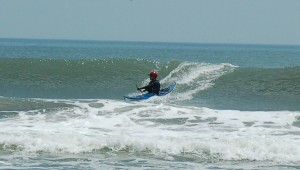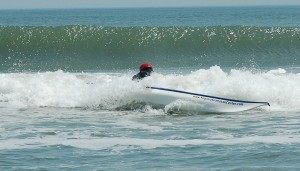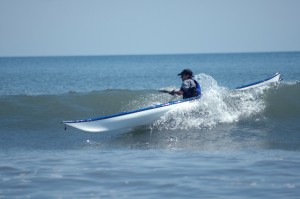The lineup at any good surf break is usually filled with short-board fun-seekers — surfboards, boogie boards and the odd surf kayak or wave ski. What many don’t realize is that longer sea kayaks are also great for surfing.
The feel of riding on a wave is an exhilarating experience, sometimes with a bit of anxiety thrown in on larger waves. When you’re in the “zone,” you feel one with the wave. Slide out of that zone, and you can get worked, so helmets are a good idea, along with a good bracing ability, and reliable roll or good self-rescue skills.

There are three basic ways to surf a wave in a sea kayak, in control at the wave crest, in control in front of the wave, and out of control side surfing. All can be fun, and sometimes you’ll experience all three variations in a single ride. However, all three techniques use different skills to keep you upright and on the wave.
Catching a wave is fairly simple and is a matter of timing and positioning. Just watch the waves coming in by looking over your shoulder as you face the direction of travel. As a wave approaches, begin paddling forward, applying more power as you feel the stern lift. If you timed it right, the wave will carry you along and you can stop paddling and switch to a stern rudder and surf the wave!
As a beginner, the ideal position when surfing a wave is with your kayak perpendicular to the wave as it heads to the beach or sandbar. You can maintain that position using a strong stern rudder and edging and as long as we stay 90-degrees to the wave, you’ll slide right out in front and race along – the “in control in front of the wave technique.” Once the wave breaks staying straight can be a bit harder.

If you begin to turn in one direction or another, often the wave will “grab” your stern and quickly push the stern so you are now sideways to the wave. This is very common once the wave breaks and you’re in or in front of the white “soup zone.” When this happens, the best technique is to edge the kayak into the wave with a strong low brace – once the stern comes around, a stern rudder won’t get you going straight again. The degree of edging (or even leaning) with your brace is based on the side of the wave.
At this point you’re side surfing, or “bongo sliding”. It’s a fun way to play in the surf, but it’s also the least effective and the most dangerous to others. In side surfing you’re generally along for the ride and the wave is in control. You can’t avoid anyone you’re surfing toward and you’re at the mercy of the wave. While side surfing is a good skill to have, it’s the least desirable surf action. If you do find yourself heading toward someone while side surfing, your best option is often to capsize and let the wave go on ahead. As you become more skilled in the surf, you can sometimes move your low brace backwards a small amount to try and bring the stern back around to the front of the wave.

To really have fun on the wave, and stay in the most control, you don’t want to slide down the face of the wave so that you’re in front of it. Instead, try to maintain your position just forward of the crest of the wave, so the breaking part of the wave is right at your cockpit. This position provides the most control while surfing, because the stern is free from the wave force, and much of the boat is out of the water with the center pivot point area having the most contact.
To master this technique, you try to catch the wave the same way, but adjust your timing and power so you ride higher on the wave, rather than down in front of the face. Adjust your speed to match the wave can be tricky, and good surf kayakers will use a modified low brace to bleed off speed – with the brace position about 45 degrees back from a standard low brace, and the back face of the blade providing a little drag with a climbing blade angle. Note, this is a more advanced technique and poses risk of shoulder injury if you don’t use aggressive torso rotation and proper form.
At this point it can be a dance between bracing to bleed off speed, and suddenly paddling forward again if you braced too much. When done correctly, you’ll find yourself staying at the peak of the wave, and you can turn your boat to one side or the other to ride across the face of the wave (head to the side that isn’t breaking yet!) much like a surfer or surf kayak, still trying to keep your stern free as much as possible, alternating between stern rudders and low braces. If you get too far sideways, you’ll end up side surfing.
When you’re surfing at the top of the wave and in control, you can peel out of the wave before it breaks by adding a low brace into the wave face and rising up and over the wave before it breaks.
Note, this type of surfing can be particularly challenging in dumping or curling waves, because if your timing is off you can get carried over the falls, or have the wave dump right on your head, so start off with smaller, spilling waves. Finally, you’ll find your skills will improve much faster if you can attend a surf zone strategies or sea kayak surfing class, where you can learn more about wave dynamics and surf etiquette.